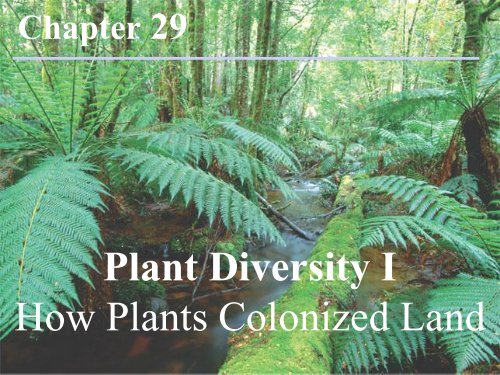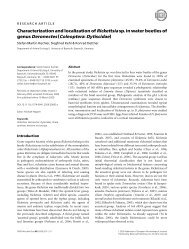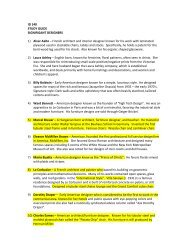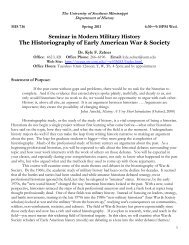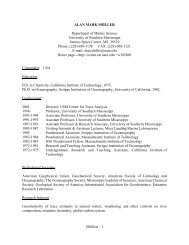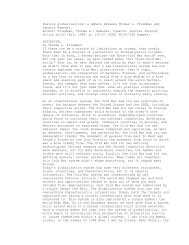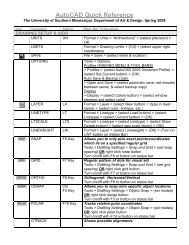Chapter 29 Plant Diversity I How Plants Colonized Land
Chapter 29 Plant Diversity I How Plants Colonized Land
Chapter 29 Plant Diversity I How Plants Colonized Land
You also want an ePaper? Increase the reach of your titles
YUMPU automatically turns print PDFs into web optimized ePapers that Google loves.
<strong>Chapter</strong> <strong>29</strong><br />
<strong>Plant</strong> <strong>Diversity</strong> I<br />
<strong>How</strong> <strong>Plant</strong>s <strong>Colonized</strong> <strong>Land</strong>
<strong>Plant</strong>s vs. Algae<br />
• <strong>Land</strong> plants evolved from __________(Chara)<br />
green algae<br />
• 4 key traits plants share with __________<br />
(__________ and __________Evidence):<br />
1. Rose-shaped complexes for __________ __________<br />
2. Peroxisome __________<br />
3. Structure of __________ sperm<br />
4. Formation of a __________
5 key traits in nearly all land plants but are absent in<br />
the charophytes:<br />
1. apical __________<br />
2. multicellular dependent __________<br />
3. __________ of __________<br />
4. walled spores produced in __________<br />
5. multicellular __________<br />
females – archegonia & males – antheridia
Characteristics of all land plants:<br />
• __________, __________, __________<br />
• cell walls made mostly of __________<br />
• chlorophylls a & b<br />
• Domain __________, Kingdom __________
Nonvascular plants<br />
1. Represented by three phyla:<br />
a. phylum Hepatophyta – __________<br />
b. phylum Anthocerophyta – __________<br />
c. phylum Bryophyta - __________<br />
Liverworts<br />
Hornworts<br />
Moss
2. The __________ is the dominant generation in<br />
the life cycle<br />
• gametophyte - mass of green, branched, one-cell-thick filaments<br />
• sporophytes are smaller; only present part of the time<br />
• spores germinate in favorable habitats<br />
sporophyte<br />
sporophyte<br />
gametophyte<br />
gametophyte
3. Bryophyte sporophytes disperse enormous<br />
numbers of spores<br />
• sporophytes remain attached to gametophyte throughout the<br />
lifetime<br />
– depends on the gametophyte for sugars, amino acids, minerals and<br />
water.<br />
• __________(site of meiosis and spore production) can<br />
generate over 50 million spores.
4. Bryophytes provide many __________ and<br />
__________ benefits<br />
• distributed worldwide<br />
• common and diverse in moist forests and wetlands<br />
• Some common in extreme environments (mountaintops,<br />
tundra, and deserts)
• Sphagnum, a wetland moss, is especially abundant and<br />
widespread.<br />
• forms extensive deposits of undecayed organic material,<br />
called peat<br />
• Wet regions dominated by Sphagnum or peat moss are known<br />
as peat bogs
THE ORIGIN OF VASCULAR PLANTS<br />
1. Two conducting tissues of the vascular system<br />
A. __________–<br />
Dead tissue, water-conducting<br />
B. __________–<br />
Living tissue, food-transporting<br />
2. Water-conducting cells are strengthened by __________<br />
and provide structural support<br />
3. __________ generation is dominant in vascular plants.
Seedless vascular plants<br />
4. Two modern phyla:<br />
a. phylum Lycophyta – __________<br />
b. phylum Pterophyta - __________, __________, and<br />
__________<br />
Club moss<br />
Whisk fern<br />
Horsetail<br />
Fern
5. Most seedless vascular plants are __________, producing<br />
one type of spore that develops into a bisexual gametophyte<br />
• both archegonia (female sex organs) and antheridia (male sex<br />
organs)<br />
• Eg., ferns<br />
sporophyte<br />
Single type<br />
of spore<br />
Bisexual<br />
gametophyte<br />
eggs<br />
sperm
6. seedless vascular plants are most common in damp habitats<br />
7. ferns produce clusters of sporangia, called sori, on the back<br />
of leaves


